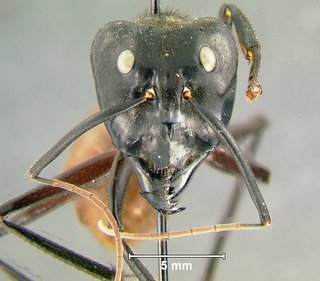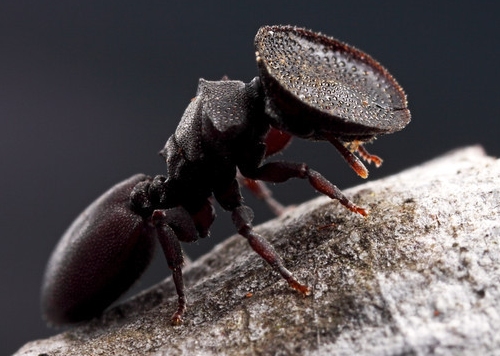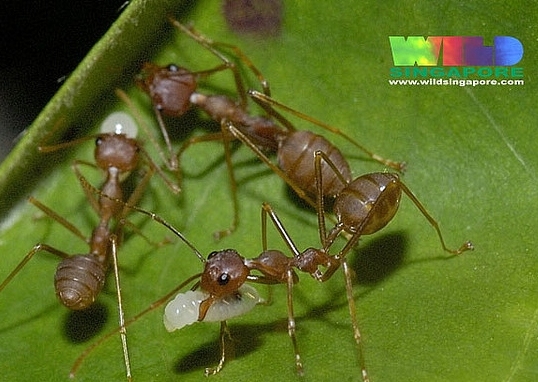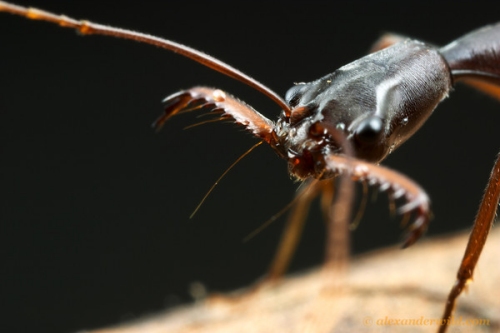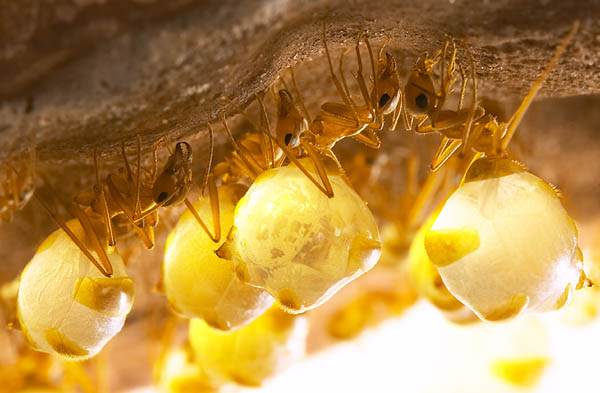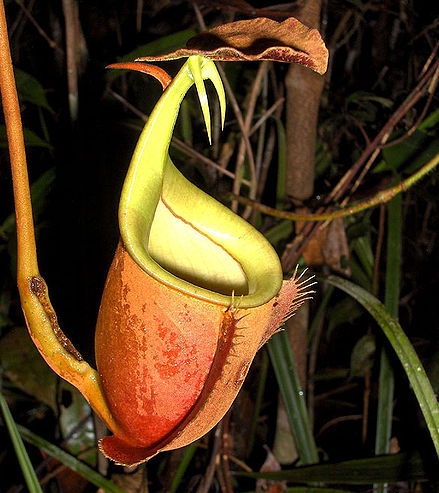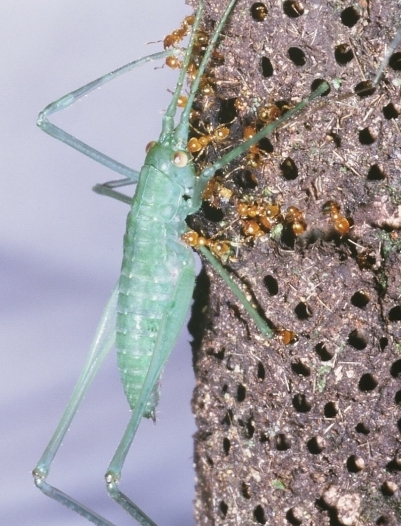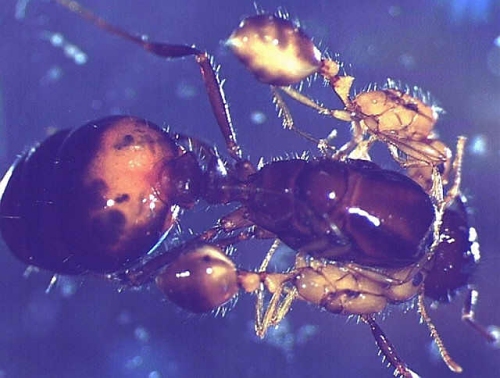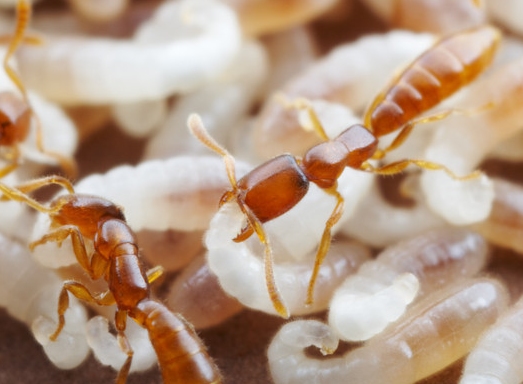| Aberrant Ants |
|
|
|
The Formicidae are arguably the most successful members of the class Insecta, dominating most other organisms by sheer number. As members of the order Hymenoptera, ants are closely related to the bees and wasps, though while these insects are only sometimes social, all known ants are fully adapted to a colonial lifestyle. We all know the basic set up of an ant colony, but the divergent behaviors and adaptations exhibited by different species could potentially fill greater volumes of scientific literature than the rest of Insecta combined, their complex lives yielding a steady stream of new discoveries to all who care to scrutinize them. The following are only a few of the most unusual forms taken by these subterranean hordes...
Unable to reproduce on their own, most of the ants in a colony have little purpose but to protect their mother queens and younger siblings, an ends to which they regularly sacrifice themselves in droves - and if you're going to die fighting, why go peacefully and leave a useless corpse lying around? Members of Camponotus saundersi colonies have a special set of over-sized jaw muscles that run nearly their entire body length, connecting with glands packed full of poison. When faced with no other alternative, the ants violently flex these muscles, rupturing themselves to splash toxic chemicals in the face of their enemy.
Members of the genus Cephalotes are often called "turtle" ants after the broad, flattened head shields of the soldier caste. The sole purpose of this strange adaptation is more or less that of a living cork, perfectly sealing off the entrance to the colony. Rather than constructing one of their own, these ants typically colonize the abandoned tunnels of wood-boring beetles, their plug-faces adapted to just the right size for just the right beetle burrows. In addition to their highly specialized headgear, some Cephalotes are also adapted for gliding, their aerodynamic bodies allowing them to swoop back to their home tree should they fall from its higher branches.
Much like our own infants, your typical ant larvae are little more than helpless freeloaders, nurtured and protected by their elder sisters until they're mature enough to start pushing dirt around. Some species, however, begin their contribution to the colony as soon as they hatch. "Weaver" or "tailor" ants like Oecophylla smaragdina are so named for their treetop nests of tightly bound leaves, stitched together entirely with the same silk larvae use for pupation. Groups of adults link together with their jaws and feet to pull leaves and twigs together, while others quickly bind them with the larvae carried gently in their mandibles.
The carnivorous Odontomachus are known as the "trap jaw" ants for their highly unusual "spring loaded" mandibles; like a mousetrap, the jaws can be locked open at high tension, snapping shut when their sensitive trigger hairs are even lightly brushed. No known predator demonstrates a faster bite, the force of which can exceed 300 times the ant's entire body weight. So powerful are these snapping jaws that the ants have been observed pressing their jaws to the ground to launch themselves backwards in one of the animal kingdom's weirdest emergency escape tactics. The jaws may even be used to catapult intruders or small, unwanted objects from a colony entrance.
In some ants of the Myrmecocystus genus, a certain portion of the workers become what are known as "honey pot" ants, or more technically, "repletes." Sugars, fats and other liquid food are fed to them by other workers until their abdomens swell sometimes to the size of grapes, which their nestmates feed from in times of
emergency. Too bloated the leave the colony on their own, the repletes are kept deep beneath the ground and heavily guarded, as many other creatures - including local humans - prize them as prey, and other ants may even attempt to steal them for their own use.
Most insects entering the pitchers of carnivorous Nepenthes plants are doomed to drown in a watery pit where they are soon broken down by the plant's digestive enzymes. The carpenter ant Camponotus schmitzi, however, forms a deep symbiosis with Nepenthes bicalcarata, the "fanged" pitcher plant. Nesting within the thick, hollow stem of the sinister-looking trap, the ants freely come and go from its deadly pool, climbing deep down into the liquid to tear apart trapped insects. Found living absolutely nowhere else, these ants depend entirely upon their living home to capture prey, and the pitcher itself actually depends upon the work of the ants to extract enough nutrients to sustain each trap, a mutual dependency only recently deduced. The insects are literally a part of the plant's digestive process, like the gut bacteria of animals.
Photo by Alain Degean
Living exclusively in the upper branches of the tree Hirtella physophora, tiny Allomerus decemarticulatus arms its territory with an ingenious and grisly trapping mechanism. Fusing together hairs from their tree with their own saliva and a living symbiotic fungus, workers build hollow structures riddled with tiny holes, lurking just inside with their minute jaws agape. Even relatively elephantine insects seal their doom with a single misstep on this living minefield; every foot and feeler to contact an ant is immediately pulled inside, pinning and stretching the victim as other workers swarm over its helpless body, sting it to death and begin cutting it apart.
A normal ant colony consists primarily of sterile, female workers and soldiershatched from the eggs of a single queen, periodically producing winged, reproductive males and females to leave the nest and start colonies of their own. Some species,however, do away with this whole complicated business and let someone else do allthe labor. Solenopsis daguerrei is just one such species, consisting entirely of queens and males with no worker or soldier caste. After mating, the female locates the colony of another ant species, sniffs out their queen and hooks itself onto her body, using pheremones to completely mask its presence while it snatches food right from the host's mouth. The colony cannot differentiate the invader's eggs from their own, and will carefully protect and raise a new generation of parasites while their own queen slowly starves to death.
Truly living up to their common name, the "dracula ants" of the genus Adetomyrma mature members of the colony are armed with wicked jaws and paralyzing stingers, but the arthropods they hunt and kill - most commonly venomous centipedes many times their size - are not for their own consumption; their diet consists exclusively of haemolymph (insect "blood") from their younger, larval siblings. Kept alive and healthy on a diet of paralyzed prey, the blind and limbless grubs are cut open by the adult's sharp mandibles and drained of blood in periodic, non-lethal amounts. Though the behavior is routine for these species, the larvae become visibly unsettled when a hungry worker enters their chamber, and even make futile attempts to flee. It should come as no surprise that a species so brutal is considered biologically closer to wasps than almost any other ant genera.
|
| EMAIL ME! |
| blog comments powered by Disqus |
